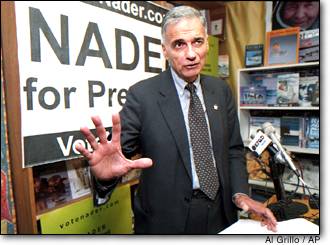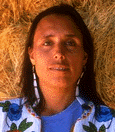|
Short Biography of Ralph Nader

For more than three decades, Ralph Nader has fought relentlessly
to protect ordinary Americans from powerful corporations and to
make government responsive, saving great numbers of lives in the
process.
Born in Winsted, CT in 1934, Nader graduated magna cum laude
from Princeton in 1955, and from Harvard Law School in 1958.
Nader came to the public's attention in 1965 when his best-selling
book "Unsafe at Any Speed" exposed unsafe cars such as General
Motors' dangerously defective Corvair. When GM went to
extraordinary lengths to discredit Nader, Nader sued them for
invasion of privacy. GM, having admitted wrongdoing before a
Senate Committee, settled the case. With the money from the
settlement, and the reputation for standing up to predatory
corporations, Ralph Nader launched the modern consumer
movement.
Activists from around the country poured in to Washington, D.C. to
work with Ralph Nader. "Nader's Raiders" successfully pushed for
numerous laws to protect consumers, workers, taxpayers, and the
environment, combating corporate abuse, and increasing citizen
access to government. Nader built or stimulated a public interest
movement consisting of dozens of organization all over the country
with hundreds of citizen leaders working daily for a just society.
On issue after issue, year after year, Ralph Nader has identified
and confronted political and corporate bosses. He has fought
against insurance companies, global trade arrangements that
override American sovereignty, and corporate lobbyists who would
block safety standards deny fair access to court for injured parties.
He has also authored, co-authored or sponsored many books,
including Action for a Change, Corporate Power in America,
Taming the Giant Corporation, Verdicts on Lawyers, The Menace
of Atomic Energy, Who's Poisoning America, Winning the
Insurance Game, and The Frugal Shopper.
His lifelong integrity and tireless commitment to the public interest
have made Ralph Nader a mainstay on lists of the most admired
and influential Americans. In an era of widespread cynicism, he
stands out as a public figure that citizens can trust to hold the office
of President.
Short Biography of Winona LaDuke:

Winona LaDuke, 37 years old, resides on the White Earth
reservation in Minnesota with her two children. She is separated
from Randy Kapashesit, a leader of the Cree Tribe in Ontario.
LaDuke began working on Indian issues at a young age, and spoke
in front of the United Nations when she was 18 years old. While
attending Harvard, she met Jimmy Durham, a well-known Cherokee
activist. During this time she began research into the health
impacts of uranium mining on the Navajo reservation. LaDuke
spent time in South Dakota, New Mexico and Arizona on additional
projects with grassroots Native organizations.
After graduation from Harvard, LaDuke accepted the job of
reservation principal of the local school and became involved in a
lawsuit to recover lands that had been taken by the federal
government and the logging industry >from the White Earth
Reservation. After losing the suit, LaDuke founded the White Earth
Land Recovery Project and began the work of recovering the
800,000 acres that had been taken from the reservation. (So far,
the Land Recovery Project has purchased 1,000 acres and expects
to acquire an additional 30,000 in the next couple of years.)
In the 1980's, LaDuke was a leader of the successful opposition to
the James Bay hydroelectric projects and was named "the most
prominent Native American environmental activist" by several
publications.
She next founded the Indigenous Womens' Network which she led
to last year's World Conference on Women in Beijing. The IWN
works on a variety of projects, including the investigation of small
sustainable industries, such as rice production and solar and wind
energy sources for use on the reservation.
In October of 1994, LaDuke was arrested while protesting the
clearcutting of both old growth and new growth that was used to
facilitate the printing of the phone books.
In Spring of 1995, LaDuke organized and hosted a national tour of
the Indigo Girls. The tour was known as the "Honor the Earth" tour,
and was organized to raise money for local grassroots
organizations. $250,000 was raised by the tour for these groups,
and over 40,000 individuals attended the concerts. In March of
1995 LaDuke was nominated by Time magazine as one of "50
Leaders for the Future."
Currently, LaDuke is writing a book on Native Environmentalism
(South End Press) and a novel for Voyageur Press; she works on
issues ranging from land restoration to organic agriculture.
Winona LaDuke is an activist for the Chippewa people of Northern
Minnesota; she serves on the board of directors of GreenPeace
USA and is board co-chair of the Indigenous Women's Network.
She also publishes the journal Indigenous Women and serves as a
program officer for a Naive American controlled foundation. She
was recently in Chiapas, working with indigenous peoples' of the
region and attending an international conference.
LaDuke has published numerous articles, has testified to
governmental bodies in the U.S. and Europe, and has spoken to
university audiences from coast to coast.
|